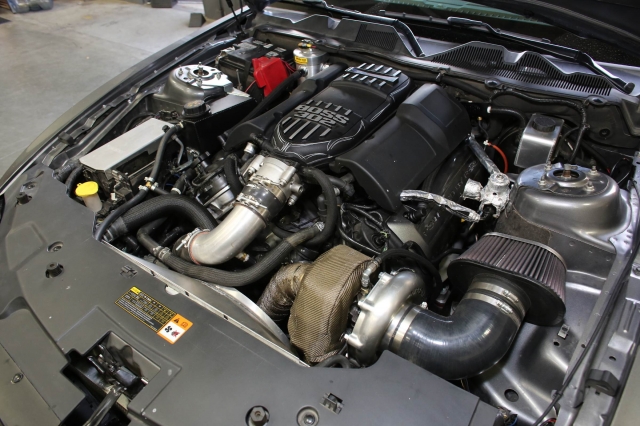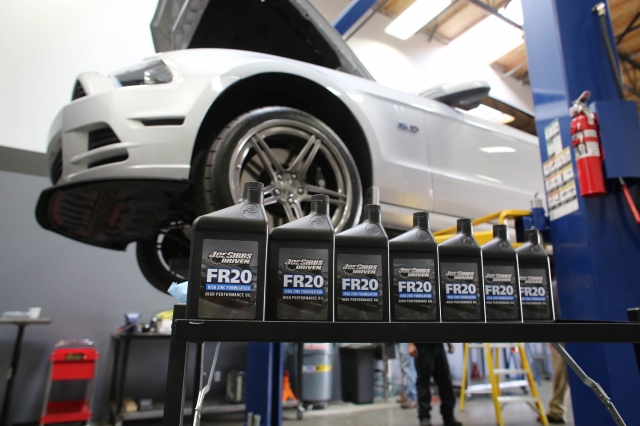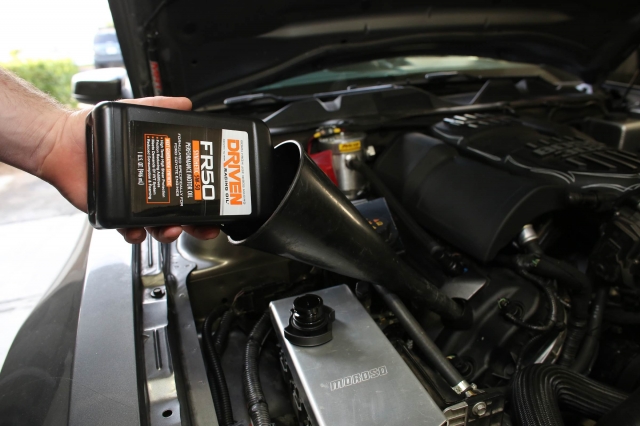Modern Mustang enthusiasts have better access to performance parts than ever before. Everything from bolt-on modifications, to camshaft swaps, and forced induction add horsepower rather seemlessly. However, as horsepower increases so does the need for internal engine parts to be lubricated properly. Pulling a case of oil off the shelf at the local parts store is probably not going to be enough for many high horsepower cars, and that’s where Driven Racing Oil comes in.
We spent some time talking with Driven’s Lake Speed Jr, about the company’s oil offerings that are specifically tailored for Ford engines like the Coyote and Modular. Driven offers two products targeted at the late model Mustang performance market in their FR50 and FR20 synthetic engine oils. Choosing the right one for your engine will not only lubricate the internal parts better, but will contribute to longer engine life as well.

Engines like our single turbo Coyote need an oil that can handle the high temps created by the turbo but still properly operate the factory Ti-VCT system.
Viscosity Index
No Viscosity Improvers
Traditional methods for improving the VI of an engine oil, and according to Speed are typically done through the addition of polymers. However, Speed says those polymers eventually wear out, and break down from the heat and load forces being applied to them. “Think of viscosity improvers like a rubber band, as you stretch it what happens? -It gets thinner in the middle, and eventually if you stretch it enough over a period of time it breaks,” he says.
Since VI improvers can break down over time, Driven doesn’t see them as an option. Instead they are using new PAO technology for their oils which give a higher VI but don’t break down over time.
As heat increases any oil begins to thin out. The rate at which it thins out is known as the viscosity index (VI). The higher the VI of an oil the better tolerance it has to thermal viscosity breakdown. Some might argue that the solution to this would be to run a higher labeled viscosity oil, but Speed explained to us that there are two reasons why that is not always a good idea.
An oil that has a lower labeled viscosity but higher VI might be maintaining or increasing its viscosity at a given temperature, than an oil with a higher labeled viscosity but lower VI under the same conditions. For example, at 300 degrees Driven’s FR20 with a VI of 160 and a labeled viscosity of 5w20 might actually have a higher viscosity than a labeled 5w30 oil with a VI of 100, at the same temperature. This is because the higher VI FR20 product can maintain a more stable viscosity over a broader temperature range.
Then there is switching to a higher labeled viscosity oil. In the world of high powered racing, especially at the NASCAR level where engines are expected to produce high horsepower, oiling becomes critical. According to Speed, “In NASCAR you try to run the lowest viscosity oil possible without sacrificing durability. The higher viscosity, the hotter the engine will run. Think of an engine like a giant mixer. The thicker the material in the mixer, the hotter the motor will get, it’s the same thing with engine oil.” Those higher temperatures lead to a faster loss of oil viscosity, and also higher engine operating temperatures which can contribute to wear or even parts failure.
Think of an engine like a giant mixer. The thicker the material in the mixer, the hotter the motor will get, it’s the same thing with engine oil. -Lake Speed Jr, Driven Racing Oil
What the engineers at Joe Gibbs Racing and Driven Racing Oil discovered was that newer oiling technology intended to help auto manufacturers run lower viscosity oils to achieve greater fuel efficiency, but still allow for long oil change intervals could be carried over into the racing world. This same new PAO technology lead to the creation of not only their race winning oil formula, but also to a whole new line of high performance oil products for enthusiasts.
While the FR50 and FR20 engine oils are not NASCAR oils, they use similar technology to create an oil that has a lower volatility, and higher viscosity index.
Volatility
Forced induction or track days come into play here. High powered engines, especially when run for prolonged periods of high RPM or high load conditions create an increase in oil temperature, especially in forced induction systems that utilize engine oil for lubrication and cooling.
The high heat can eventually cause oil vaporization. That vaporized oil can then be drawn through the PCV system and back into the combustion chamber. Vaporized oil in the intake and combustion chamber impacts fuel octane level because of its high flash point. That oil can also coat intake passages, valves and the tops of pistons with residue and deposits.

When it’s time to change the oil in Project Silver Bullet, Driven’s FR20 offers a strong viscosity index and excellent volatility for our supercharged engine, while maintaining the stock viscosity necessary to properly work the TIVCT system.
According to Speed, Driven’s FR20 and FR50 engine oil have a lower volatility of around five-percent versus fifteen-percent for most off-the-shelf engine oils. This means they are less prone to vaporization. “Excessive oil vapor in a high-boost racing application could be the difference between detonating and destroying an expensive engine or winning a race at the track,” says Speed.
FR20
 For high output modular Ford engines including the Coyote, there is a need for an engine oil that is the same viscosity as what Ford recommends from the factory, but is more stable under the heavier shearing loads, and heat from modified engines.
For high output modular Ford engines including the Coyote, there is a need for an engine oil that is the same viscosity as what Ford recommends from the factory, but is more stable under the heavier shearing loads, and heat from modified engines.
“Unless you’re changing bearing clearances or the oiling system, you should stick with the factory recommended viscosity,” says Speed. So in modified Coyote and modular engines, Driven’s FR20 engine oil offers the benefits of OE recommended viscosity, with better volatility and VI than an off the shelf product.
While some enthusiasts balk at the idea of running lightweight viscosity oils like 5w20 in their engines, the truth is that overhead cam engines rely on those lightweight oils. Unlike a a cam-in-block engine, the camshafts are all the way at the top of the cylinder head, the last place to get oil. This means that when the engine is cold, it’s critical for oil to reach those camshafts as quickly as possible creating the need for a lower viscosity oil.
Changing to a higher viscosity oil can potentially slow down the progress of oil reaching the cams in a timely manner. When you throw in the pressures needed to operate variable valve timing system like on Coyote powered Mustangs, having the proper viscosity is even more critical, since the engine relies on hydraulic pressure from the engine oil to operate.
FR50
For high output modular engines that have had significant oiling system changes, such as to the bearing clearances or oil pump, Driven has their FR50 oil. Offering the same VI, and low volatility index benefits as the FR20 oil, FR50 is a 5w50 oil that will help looser bearing clearance engines maintain proper oil pressure. This is especially critical for Coyote and other variable valve timing engines that rely on that pressure to operate their variable cam timing systems.
Driven saw a need in the marketplace for these two products and came through with their FR50 an FR20 oils. As Speed explains, “We don’t like to think of ourselves as an oil company, rather we think of ourselves more as a solutions company. We look at problems in different segments of the performance industry and try to understand those problems, the applications that they impact, and then find a solution for them.”
We’ve been using Driven products in several of our Power Automedia project builds, and have been pleased with the results. For more information on oiling and viscosity, be sure to check out the Driven web-site.

























